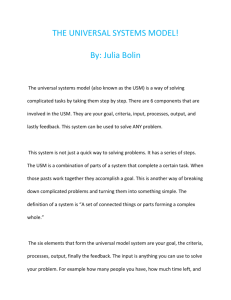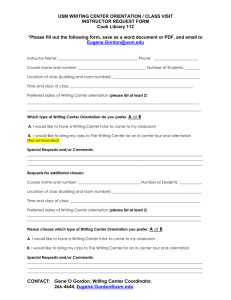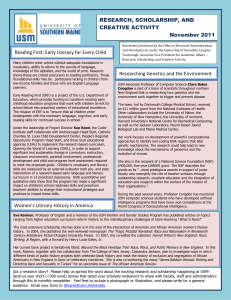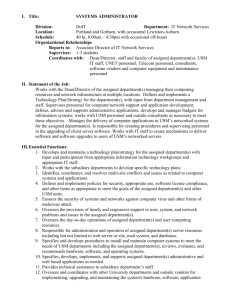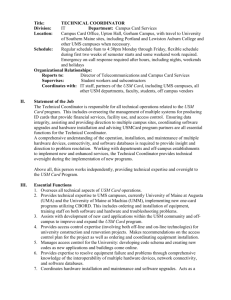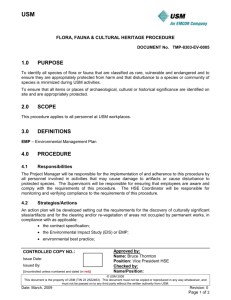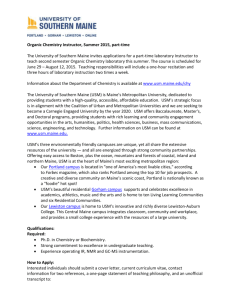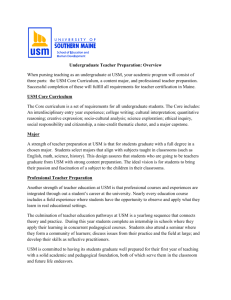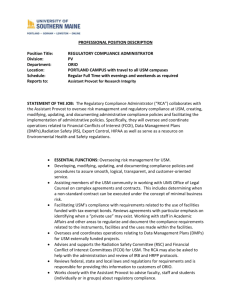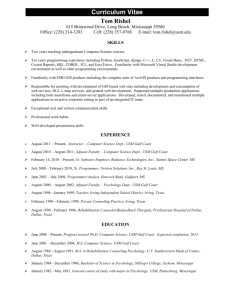Attributes of the Academic Model of the Future and the Implications
advertisement
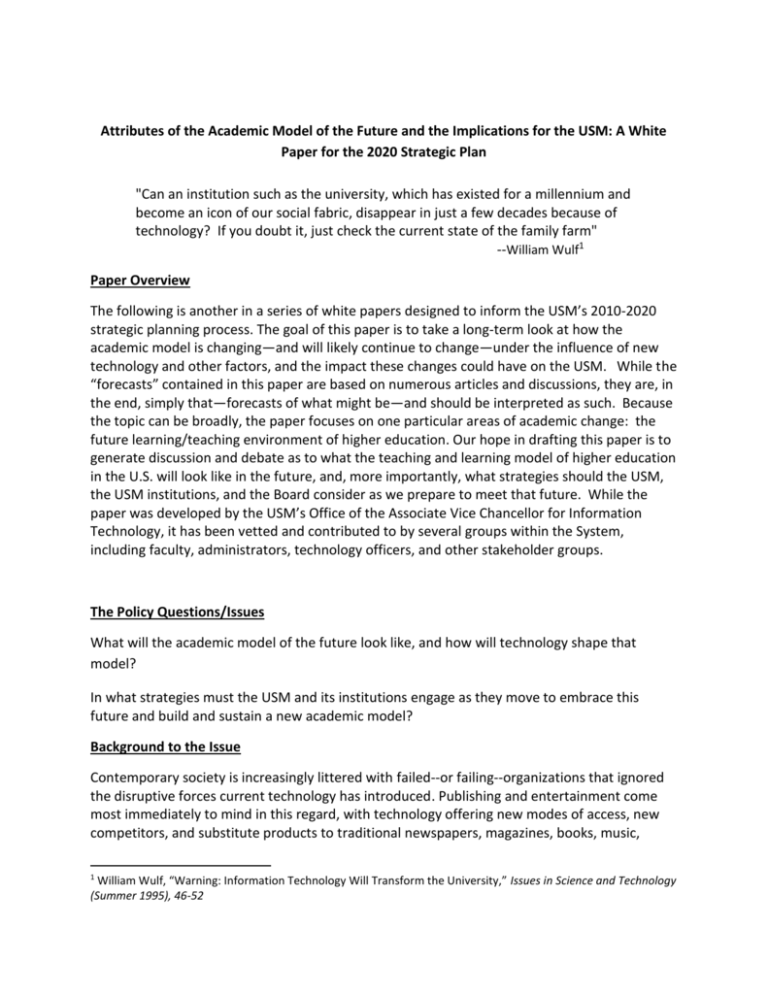
Attributes of the Academic Model of the Future and the Implications for the USM: A White Paper for the 2020 Strategic Plan "Can an institution such as the university, which has existed for a millennium and become an icon of our social fabric, disappear in just a few decades because of technology? If you doubt it, just check the current state of the family farm" --William Wulf1 Paper Overview The following is another in a series of white papers designed to inform the USM’s 2010-2020 strategic planning process. The goal of this paper is to take a long-term look at how the academic model is changing—and will likely continue to change—under the influence of new technology and other factors, and the impact these changes could have on the USM. While the “forecasts” contained in this paper are based on numerous articles and discussions, they are, in the end, simply that—forecasts of what might be—and should be interpreted as such. Because the topic can be broadly, the paper focuses on one particular areas of academic change: the future learning/teaching environment of higher education. Our hope in drafting this paper is to generate discussion and debate as to what the teaching and learning model of higher education in the U.S. will look like in the future, and, more importantly, what strategies should the USM, the USM institutions, and the Board consider as we prepare to meet that future. While the paper was developed by the USM’s Office of the Associate Vice Chancellor for Information Technology, it has been vetted and contributed to by several groups within the System, including faculty, administrators, technology officers, and other stakeholder groups. The Policy Questions/Issues What will the academic model of the future look like, and how will technology shape that model? In what strategies must the USM and its institutions engage as they move to embrace this future and build and sustain a new academic model? Background to the Issue Contemporary society is increasingly littered with failed--or failing--organizations that ignored the disruptive forces current technology has introduced. Publishing and entertainment come most immediately to mind in this regard, with technology offering new modes of access, new competitors, and substitute products to traditional newspapers, magazines, books, music, 1 William Wulf, “Warning: Information Technology Will Transform the University,” Issues in Science and Technology (Summer 1995), 46-52 movies, and even television (which was itself an industry that resulted from the introduction of a disruptive technology). Healthcare has undergone significant changes in delivery, outcomes, and cost----and is continuing to struggle to find a stable model in a rapidly changing environment. There is an oft told story that in the early 20th century railroads planned based on the view that they were in the railroad business, when the correct perspective should have been that they were in the transportation business. The results of that misperception can be easily seen. Based on these examples, we might reasonably ask, “Is higher education immune from similar disruptive changes? Do we have the correct perception of what we are about?” These are especially pertinent questions in our current environment, where economic pressures have reduced state funding, market losses have impacted endowments, parents and students are more cost conscious than ever, self-administered accountability processes are coming into question, and competitors offering convenience and certification are taking increasing numbers of students (for instance, according to the Chronicle of Higher Education, enrollment in the nation’s for-profit, career colleges has grown by an average of 9 percent per year over the past 30 years, compared with only 1.5 percent for all institutions). While historically higher education (at least the non-profit segment) has been slow to change whether at the industry level or the institutional level, this is a time of exceptional pressures and higher education institutions may well be forced to change--just as other industries and organizations have had to recognize that change may be a matter of survival, desired or not. The USM must be prepared to recognize and embrace the changes that technology is having on the academic model in order to respond to new ways student learn, and promote more effective teaching, and ensure the USM and its institutions operate at the highest levels of effectiveness, efficiency, and accountability. This includes recognizing and responding to changes in the way Millennial and NetGen (Internet Generation) students, all reared in the digital age, will expect to learn and how teachers will need – and expect – to teach. Trends in the Academic Teaching and Learning Model of the Future While precedents for learner-centered models of higher education exist, such models traditionally have not been scalable and thus have not been adopted en masse. The result has been that for most of the 20th century, American higher education—driven by an ever expanding demand for access—took on the more industrialized, but scalable approach to education that we recognize now: teacher-centered learning, chalk and blackboard-oriented large lectures, multiple sections frequently taught by graduate students or adjuncts, etc. Within the past decade and a half, however, advances in information technology have progressed to the point that they can now serve as true “game changers.” Through new technological tools we can begin to create a scalable, individualizable, learner-centered approach to higher education. The following is an attempt to highlight some of the attributes of such an environment, and how it will differ from education as we have known it. Additionally, we explore the impact of the changing model on institutional and USM practices. 1. Traditional fixed time and place learning environments will be replaced by more flexible anytime and anywhere opportunities for learning. While growth in fully online courses and programs is likely to continue, all courses, even those that depend on face-to-face interactions, will be affected by the expansion of online access that will make information to support course-based interactions and supplementary communications more productive. Outside content and expertise will be brought into class as well as, in many courses, time in a classroom will diminish as interactions become less defined by class time. Implication for students and faculty: While faculty will continue as content experts, in many cases they will focus on orchestrating learning interactions, faculty to student and student to student, rather than focus on classroom presentation and discussion. Assessment will have to take into account measures other than classroom participation per se. Implication for the institution: The historic view of classrooms as primary learning/interaction spaces will have to reconsidered. Classrooms will have to be technology enabled, and other areas of campus will have to be recognized as potential learning spaces and designed accordingly. Academic policies that focus on class attendance may have to be reconsidered. 2. Learning increasingly will be framed by attacking real world problems, especially in STEM areas, rather than being limited to artificial problems within the capability of traditional “low tech” instructional tools. With advanced location, computation, and visualization technologies, students will be able to collect data, analyze it, and visualize the results related to concrete, real world problems. Additionally, virtual environments will become crucial tools in supporting this type of active learning. Simulations will allow students to better understand complex issues, make problem solving more interactive, allow experimentation in areas that are not safe to normally experiment with, and do so with less cost per student than current methods. Multi-user games will be increasingly used to engage students in hands-on learning experiences. Immersive environments, such as the current “Second Life,” will combine many of the above elements and will be particularly relevant to distance learning courses. Students and faculty can interact in a virtual classroom that has all of the elements of a traditional classroom and many elements that can’t be replicated in a traditional classroom, but there will be no need for students and faculty to be in a physical location. o Implication for students: Learning will be a more engaged process and more immediately relevant. o Implications for faculty: Many individual faculty members may not be able to develop the materials involved: simulations, games, etc. Therefore, this trend will possibly involve acquisition of new materials, an investment which faculty may not have the resources to undertake. o Implications for institutions: Just as institutions have invested in specialized software such as statistical packages, mathematical analysis, etc., they may have to invest in the materials described above. 3. The model for course material development will change. The development of high quality, technology based course materials often requires special skills. A notable proof of concept initiative is the Carnegie Mellon University “Open Learning Initiative,” in which course materials are developed by teams of faculty and cognitive scientists. Carnegie Mellon makes these course materials widely available and individual faculty members can modify them to fit their individual course. While, the Open Learning Initiative might be at the leading edge of course material development, a more affordable but scalable approach will be the facilitation of having faculty members sharing instructional materials of all kinds. This can be encouraged by the creation of repositories of such materials so that the initial cost of creating them can be amortized by multiple re-use as UMUC currently does in its course development. Another “open” approach is that of the MIT Open Courseware Initiative that shares full courses and supporting materials. Implication for students and faculty: Students in multi-section courses should have more consistent outcomes since there will be more commonality in materials, also faculty will be able to share the best practices of their colleagues more easily. Implication for institutions: Course development and delivery is perhaps the largest investment of resources an institution may make. As teaching and learning move from face-to-face in the classroom to a mix of in-class, online, and other technology enabled activities, leveraging materials development will become an important initiative for institutions. Implication for the USM: Sharing materials need not be restricted to an activity for faculty at a single institution. In fact, given that each institution might have a small number of courses in each discipline where materials can be shared, sharing across institutions makes considerable sense. This is an area where the USM can have strategic impact on the efficiency of the academic programs.2 4. Learning will continue to evolve from an overwhelmingly individual-centered activity to a more collaborative process. Because information technology tools will facilitate the exchange of information much more easily, more quickly, and more effectively among far greater numbers of people than is possible today, they will speed the current trend toward more collaborative learning. This trend, in turn, will mesh well with the needs for team approaches in business and collaboration in creative efforts, research, etc. Technology’s influence will be felt not only in providing the underlying tools for collaboration but also in allowing it to take place anytime and anywhere the collaborators desire—both synchronously and asynchronously. Implications for institutions: Institutions will have to design more collaborative work environments and license collaboration tools. 5. Learning and assessment will be more integrated. Assessment will be repurposed to be an integrated part of the learning process not just a series of independent hurdles that the learner must surmount. Technology increasingly will allow individualized assessment that responds to the stage of learning and learning problems that each learner faces at any time in the learning process. As a secondary effect, at-risk students can be identified early in their careers and intervention can be offered to support them. For all students, faculty will be able to use information about their learning styles, strengths and weaknesses to better tailor their educational experience. These represent a significant change in thinking about the learning process as well as tying technology to broad USM initiatives such as Closing the Achievement Gap and Reducing Time to Degree. 2 Implications: While individual faculty members currently collect a lot of data about individual student performance, it is typically used by that faculty member only to award a final grade. The trends described here will require a new view regarding the analytics related to student learning and progress. At one end of the spectrum, depending on the discipline, systems can track and respond to problems each student may have with course material. At the other end of the spectrum, systems can track and flag problems a student is having with progress toward a degree or potential risk of dropping out of school altogether. Fundamentally, this trend is based on continuously It is recognized that there are significant Intellectual Property and policy implications inherent in sharing materials. Still, other institutions have addressed these and this is an area where the USM can improve both effectiveness and efficiency. collecting, analyzing, and reporting----to the student, to the faculty member, and perhaps to the institution----data related to learning progress. 6. Certification will become more competency oriented. Increasingly, it will be a matter of ‘what one knows’ rather than ‘what courses one has passed’ that will determine qualifications and certification. It has long been recognized that the need for learning has become life-long and traditional age education is only a foundation. Subsequent educational needs may well require certification, but the ability to demonstrate knowledge is the key component. This component will migrate into traditional age education as well. Information about an individual’s life-long learning will be kept in “ePortfolios.” Such a portfolio will be a personal repository of outcomes of learning experiences and creative activities. It will have components accessible only to the individual as well as components where the individual can share past outcomes with others as appropriate. A portfolio can be used to inform teachers in later grades, universities in later education, and employers in the workplace about the capabilities and competences of an individual. An implication of a competency-based model is that it will matter less where and how one learns material. This, together with the increased flexibility of learning environments described in Trend 1, will mean that students will increasingly look beyond a single institution for education and certification. This has been true for adult learners and may soon be true for more traditional age learners. o Implication for institutions: Institutions may well have to reconsider transfer credit (say from an institution that already gives credit by examination only); residency; matriculation; etc. o Implication for the USM: Does the USM wish to facilitate degrees under more flexible institutional residency and matriculation requirements? 6. Physical aspects of the campus—such as the library, the traditional “heart” of the academic enterprise—will evolve into or be combined with spaces and facilities that address the requirements and usage needs of virtual, online assisted, and fully online learning environments. For example, since most content will be created digitally and delivered digitally, libraries and librarians will have changing roles. While the historic record is currently represented in physical objects (books, journals, photos, music, etc.), new acquisitions will increasingly become digital. Thus library print acquisitions will decline dramatically and space needed to house print materials will shrink. Already, libraries are often serving as meeting places for collaborative work. Some library spaces will be restructured as technology-assisted, comfortable, socially-connected learning environments, with consolidated and integrated IT assistance, student support services and library services. Increasingly, content will be published in multi-media, hyperlinked formats, with dynamically evolving relationships among constantly growing assemblages of linked comment and commentary. Librarians will have an increasing role in helping patrons identify, access, evaluate, assimilate and present the content they need regardless of the mode of delivery. Librarians, collaborating with technologists, will also have roles in establishing standards for developing, managing and preserving repositories of both print and digital content, and preserving that content over time despite expected changes in production and access technology. Similarly, classrooms are moving from places where lectures can be given to more flexible spaces that are technology enabled and support differing teaching and learning approaches. Not only will they support new modes of student-student, student-teacher, and classoutside expert interaction, but they will support review of class sessions after the fact. Implication for institutions: Academic space planning and design has to correlate with changes in academic program delivery as described above.
